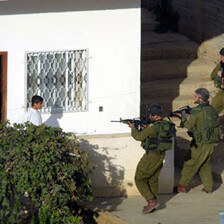
A Palestinian dressed as Santa Claus near the controversial separation wall in the West Bank city of Bethlehem, 23 December 2006. (MaanImages/Moamar Awad)
Looking back at Christmas in Bethlehem, I found there were too many absurdities to compensate for the familiar gay scenes of drum bands and parents with kids on their shoulders characteristic for the entry of the Patriarch and next day’s festivities around Nativity Square.
Imagine, the Patriarch entering Bethlehem through the old Jerusalem-Hebron road, passing through a city quarter deadened by so many circling Walls that a talented photographer can make a surrealistic exhibition out of it. Three gate locks - at the main Wall on the road to Jerusalem and then two more gates near Rachel’s Tomb - open up sequentially and allow the Patriarch and his following to drive through a road which the rest of the year does not exist. According to the religious status quo regulations, dating back to the Turkish times, the Patriarchs (Roman-Catholic, Greek-Orthodox and Armenian, each at different Christmas Days) follow this route along Rachel’s Tomb. In fact, when doing so they do not pass one tomb but several tombs as some houses near Rachel’s tomb are surrounded by Walls and actually resemble tombs. Weeks ago somebody told me that there is a legal term for what is happening to Bethlehem and several other Palestinian cities: urbicide, the killing of a city, or quarters of a city.
Imagine, the Israeli government announcing in advance of Christmas that they hand out little presents and Christmas cards to pilgrims entering Bethlehem. To gauge the depth of the insult committed here, one has to picture the entrance to Bethlehem. As a visitor coming from Jerusalem, and after having followed the Christmas lights above the Hebron road, you face the concrete 9-meter high Wall which is decorated with armed watchtowers and an enormous banner declaring “Peace Be Upon You.” There the pilgrims got their Christmas present. In fact, not so many presents were distributed; I think the show took place only on Christmas day.
Imagine, says Mary, the people in Bethlehem receiving a full month tasreeh (permit)! Wow, not one day, not a permit to go to a certain destination like a hospital, but a permit to everywhere in Jerusalem and further. A ticket to Freedom? A brief explanation for those who are lucky enough not to know the intricate details of the permit “system.” Up until now Palestinian Christians sometimes get permits during a Christian occasion. Such permits are for one day or a couple of days. The permits are usually arbitrarily distributed among those who submitted a request through their parish church. (Most do not have the energy to ask for permits). It often happens that half of the family gets a permit and the other half not; the wife yes, the husband no, for example. This Christmas it seemed that many - not all, people keep reminding me - got a permit. The system doesn’t have logic except uncertainty, arbitrariness, and people becoming tired and wanting to leave the city. Mary commented that she felt “sad to be happy” for the month-long permit. “That’s how far we got, to be happy with a permit. We are aired, like prisoners in a prison and animals in a zoo.”
Imagine, a pedestrian going from Bethlehem to Jerusalem. You pass by a two-way cage-like corridor stretching a hundred meter along the Wall. Indeed as if you are aired in a prison. The cage was erected after last Ramadan when fights broke out between Moslem pilgrims and soldiers after the pilgrims were stopped. The new cage is intended to keep the mice in queue, as Mary puts it.
Imagine, going with your tasreeh for a brief holiday to the lovely village of Ein Karem near Jerusalem. Ein Karem is known as the place where the Virgin Mary met Elisabeth, and where Elisabeth’s unborn son John (the Baptist) jumped of joy. We were joined by a Palestinian family who used to live here before 1948. After the Israeli-Arab war, the refugees were not allowed to return, the houses declared absentee property, and subsequently taken over by Jewish immigrants, many of them artists. While the family was evoking old memories from the time they and their ancestors lived there, an inhabitant asked them: “Why did you leave?” “No comment,” said Mary. Afterwards, in the taxi, the family recalled how at the time (April 1948) the bodies of the Palestinians killed and injured in nearby Deir Yassin were carried through Ein Karem.
Did I ever tell you the following Christmas story? A few years ago, a Nativity scene was played out by Palestinian kids from a private school in Bethlehem. Everything went as it should until the Holy Family reached the inn. The inn keeper threw open the Gate and told the Holy Family:
“Ahlan Wasahlan!” [welcome!]. The Arab hospitality script won it from the Biblical script. The audience was in stitches.
The people here do not need permits, favors, or justifications - just freedom.
Related Links





